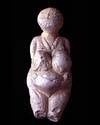| . |  |
. |
Berkeley CA (SPX) Feb 07, 2007 Karin Sanders, associate professor and chair of the Scandinavian department, was just an infant when two well-preserved bodies from the Iron Age surfaced in peat bogs in her native Denmark, and a teen when The Bog People, P.V. Glob's scientific-detective story about the discoveries, became a European best-seller. Her fascination with the likes of Tollund Man (one of the most famous of all "bog bodies," found in 1950) led her to research their ongoing displays in museums around the world. She also developed an interest in various literary and artistic depictions of the mysterious mummified or skeletal human remains that have been discovered in bogs throughout northwestern Europe since the 18th century. When bog bodies were first found, their remarkable preservation led many to assume that they had died recently, likely murdered. The acid- and oxygen-free peat wetlands into which the bodies were deposited preserved their skin and internal organs (though rarely the skeleton), and the acidity and cold temperatures of the bogs deeply tanned the skin, often turning the bodies a curious orange or red. What is clear from the majority of the approximately 1,000 bog people found so far, Sanders says, is that they met a violent end before ending up in the bogs. Many were stabbed, strangled, hanged, or otherwise brutally treated. One ancient historian wrote about an ancient Norse practice of tossing into the bogs the bodies of those "who defiled themselves" and broke customs of their time. Others have theorized that the bog people were probably criminals, or perhaps the chosen victims for sacrificial rituals. The Nazis, Sanders notes, claimed most bog people were homosexuals and that their deaths were to be seen as a just end warranted by their unnatural lifestyles. Literature and art developed around the bog people as early as the 1830s, says Sanders, and continues today. Most artists have taken a nostalgic view of the past, while others have chosen to depict the bodies as abject and grotesque, sometimes awash in blood-red paint. Still others have imaginatively arrayed bog bodies in contemporary settings.
Bog As Memory Bank But in the course of her research she uncovered such a wealth of information that she now is finishing a lengthy book examining how what she calls "human time capsules" have been depicted in poetry and literature by others, including Belgium's Hugo Claus (of the post-World War II avant-garde Cobra movement) and the American modernist William Carlos Williams, among others. This semester, Sanders is teaching Word and Image, a course that will include reading both the history of bog bodies and some of physicist Stephen Hawking's A Briefer History of Time. (The book is being provided free to freshmen in the College of Letters and Science in advance of a March 13 campus presentation by Hawking, and several spring courses related to the book are on offer in addition to Sanders'.) Sanders sees a link between the Hawking book and how the well-preserved bog bodies seem to alter the sense of time. Beyond that, Sanders thinks that now is an opportune moment to consider how bog people have been interpreted since their discovery more than 200 years ago. Such study can shed light on what she calls the "elastic boundary" between the past and present, the evolution of ethics and aesthetics, and issues of race, gender, national identity, political ideology, facial reconstruction, and pop culture . . . and what it means to be human - whether alive or dead. These are critically important topics, says Sanders, "at a time when nations are trying to think over, sometimes in scary ways, what it means to belong to a certain nation or culture." Related Links UC Berkeley All About Human Beings and How We Got To Be Here  Champaign IL (SPX) Feb 07, 2007
Champaign IL (SPX) Feb 07, 2007Hold on to your bearskin hats and your macrame snoods, readers: You are in for a wild verbal ride through your deep, deep past. The authors of a new book have fashioned a 16-chapter prehistory theme park worthy of Disney, but in their confection, lame, even egregious, past assumptions about our past are hunted down and slain, and stars - in the form of womankind - are born. |
|
| The content herein, unless otherwise known to be public domain, are Copyright 1995-2006 - SpaceDaily.AFP and UPI Wire Stories are copyright Agence France-Presse and United Press International. ESA PortalReports are copyright European Space Agency. All NASA sourced material is public domain. Additionalcopyrights may apply in whole or part to other bona fide parties. Advertising does not imply endorsement,agreement or approval of any opinions, statements or information provided by SpaceDaily on any Web page published or hosted by SpaceDaily. Privacy Statement |